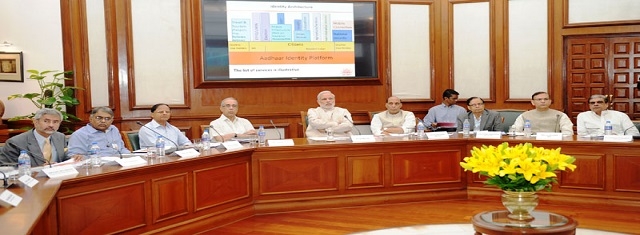News
Prime Minister Calls For Accelerating Delivery Of Benefits Through Aadhaar & DBT
Review Of UID And DBT

Mr. Narendra Modi chairing a high-level meeting. (Source: PIB/GR/TYP/BIN/USPA/WN)
USPA NEWS -
The Prime Minister, Mr. Narendra Modi chairing a high-level meeting to review the progress of UID and DBT, in New Delhi on June 18, 2015. The Prime Minister directed concerned officials to identify applications, where concrete results can be achieved in the next two months.
The Prime Minister, Mr. Narendra Modi has called for accelerating the delivery of benefits, and expanding the applications of the Aadhaar (UID) platform.
The Prime Minister reviewed the progress of UID and DBT at a high-level meeting on June 18. The Home Minister, Mr. Rajnath Singh, Ministers of State in the Finance and Home Ministries Mr. Jayant Sinha and Mr. Haribhai Chaudhary, Vice Chairman of the NITI Aayog Mr. Arvind Panagariya, and senior officials from various Ministries of the Government of India attended the meeting.
The Prime Minister reviewed the progress of UID and DBT at a high-level meeting on June 18. The Home Minister, Mr. Rajnath Singh, Ministers of State in the Finance and Home Ministries Mr. Jayant Sinha and Mr. Haribhai Chaudhary, Vice Chairman of the NITI Aayog Mr. Arvind Panagariya, and senior officials from various Ministries of the Government of India attended the meeting.
The Prime Minister called for expansion of the applications of the Aadhaar platform, so that its benefits can be extended to as many public services as possible. He directed concerned officials to identify applications, where concrete results can be achieved in the next two months.
Appreciating the progress made in some areas, the Prime Minister directed the strengthening of the institutional mechanism related to Aadhaar and DBT, using a portion of the savings being achieved. He also asked concerned officers to examine the possibility of incentivizing states through a one-time sharing of a portion of the savings, as a result of successful implementation of DBT schemes.
Appreciating the progress made in some areas, the Prime Minister directed the strengthening of the institutional mechanism related to Aadhaar and DBT, using a portion of the savings being achieved. He also asked concerned officers to examine the possibility of incentivizing states through a one-time sharing of a portion of the savings, as a result of successful implementation of DBT schemes.
The Prime Minister Mr. Narendra Modi was informed on the occasion about the current status of Aadhaar enrolment, and the direct transfer of benefits in various sectors. Among other savings, the Prime Minister was informed that a total of 14 to 15 percent saving is being achieved in LPG subsidy alone, as a result of elimination of leakages, and de-duplication.
Liability for this article lies with the author, who also holds the copyright. Editorial content from USPA may be quoted on other websites as long as the quote comprises no more than 5% of the entire text, is marked as such and the source is named (via hyperlink).





